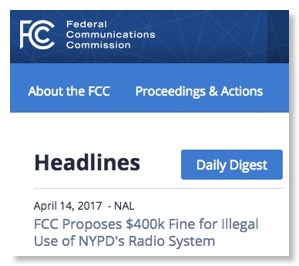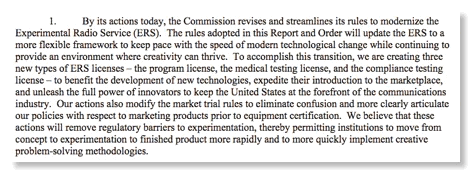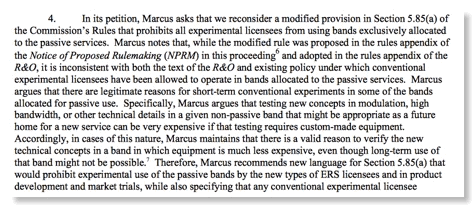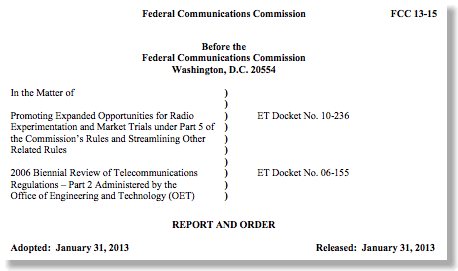Two Recent FCC Actions Highlight Chronic Concerns That Spectrum Policy Resources at FCC Are Too Low
Field Enforcement

- "On August 1, 2016, the Commission was alerted by a posting on Twitter about an unlawful intrusion on the NYPD’s radio system, whereupon the Enforcement Bureau dispatched an agent from its New York Field Office (New York Office) to confirm the intrusion and offer assistance."
- "On September 30, 2016, the NYPD contacted the New York Office and advised that it had arrested two individuals, Mr. Peralta and an accomplice, in connection with unauthorized transmissions made on the NYPD’s radio system."
Does the downsized New York FCC field office have the resources today to have helped NYPD to solve this case had they been asked?
When I was in EB's predecessor, FOB, one of the top priorities of field officer managers was to maintain good relations with local public safety officials so that they could help quickly with public safety interference issues that were of the highest priority then and well as now. So why didn't NYPD tell FCC about this case? Perhaps top FCC officials should ask why! (I suppose the FCC IG could look into to it, but we all know that unlike Curious George he is not at all curious about FCC operations that risk discovering something embarrassing to agency leaders. He is a great team player though!)
Should we look forward to this $404,166 NAL helping to reduce the national debt? Don't count on it. EB is rather evasive about how many NALs are actually paid and this type of fine against an individual has little likelihood of a substantial recovery. Perhaps a more relevant question is why this didn't result in a § 333 criminal prosecution? Now US Attorneys are reluctant to get involved in Communications Act cases involving interference to TV reception or amateur radio shenanigans, but this sounds like what § 333 was intended for and was also a criminal violation of § 301. When I worked in the old FOB, I was personally involved in 4 different successful criminal prosecutions for radio violations (2 satellite jamming cases, 1 aviation air traffic control intrusion case, and 1 maritime false distress case) during a 5 year period. It is unclear when EB was last able to ask and convince DOJ to prosecute any case, perhaps 20+ years ago? Does EB even know how to make such a request to DOJ? Does it even have the files on the old successful FOB referrals to DOJ?
Part 5 Experimental Program Licenses
On April 14th FCC's blog had a new post from OET Chief Julius Knapp entitled "Open for business: FCC's New Experimental Licensing System Accepting New Applications". It failed to mention the origins of this new program, probably because the timing might be embarrassing. On January 31, 2013 FCC adopted the Report and Order in Docket 10-236 updating the Part 5 Experimental License Program. (Note this was 26 months after the NPRM had been adopted — indicating that this docket was not exactly on the fast track. However, both the NPRM and the R&O were released on the day the Commission adopted them indicating FCC leadership was trying to maximize PR since this is treatment only PR-worthy decisions get due to perennial FCC "back office " problems. )
The R&O said about the new types of licenses:

These are all commendable goals but the 4+ years delay between the adoption of the R&O and the opening of the updated application web site that accepts applications is unexplained. There are some plausible issues dealing with a reconsideration of the R&O which was itself on the "slow track" and was slowed further by a 2 month delay in publishing the R&O in the Federal Register. OMB approval was needed for some details of the new website since it gathered information. But the most likely explanation for much of the years of delay was the lack of resources in FCC to modify the website that handles experimental applications. Indeed what was actually done was to add a new section/dashboard so that the basic experimental license website created in the 1990s remains unchanged. (It was state of the art 1990s technology in how it implemented the FCC Form 442 of the era but is a now real pain to use for even simple applications for anyone who doesn't use it on a regular basis due to design quirks and poor instructions.)
So both of these problems are probably cause by chronic low FCC funding for spectrum policy issues other than auctions and 5G. While certain FCC Title II activities are controversial, Title III activities generally are not. Indeed, Title III is both a profit center for the Treasury and a major growth enabler for the GDP. Why far the resources for FCC in this area so low that key activities are not adequately funded. Note that this is a bipartisan issue and both parties are responsible!
The WTB Auction Division is adequately funding because it can "skim" off auction proceeds. (When I was working at FCC many people noted that all the staff in the Auction Division had large displays on their PCs because their were supposedly needed for auctions - even for time clerks?) Ofcom is not funded by an appropriation from the UK Parliament, it is funded by the fees it collects subject to limits set by the agency that supervises it. Perhaps it is time to try to remove the spectrum regulation of FCC from regular politicized appropriations process since it is already supported by various spectrum fees? Recall that Wi-Fi, Bluetooth, and many other unlicensed marvels all started with a $55,652 FCC-funded study at MITRE Corporation in 1980 and today's reality is that FCC can not afford studies of new technology options and can't even afford its own spectrum enforcement activities and implementation of new rules!
FCC Approves MSS Part 5 Reconsideration Request

On July 8 FCC released an MO&O&FNPRM in Docket 10-236, formally captioned “Promoting Expanded Opportunities for Radio Experimentation and Market Trials under Part 5 of the Commission's Rules and Streamlining Other Related Rules”. This decision deals with 3 reconsideration requests, one of which was filed by your blogger. They relate to the January 31, 2013 FCC decision to revise the experimental licensing rules. In that decision the new rules forbid for the first time all experimental licenses in bands with only passive allocations. While this language had been in the NPRM’s draft rules, it was never mentioned in either the discussion sections of the NPRM or the R&O and quite probably was a drafting error.
We got involved in this issue after signing a new client in May 2013 who was having problems getting experimental licenses for millimeterwave technology experiments. In researching the issue, we noticed that the new rules were about to go into effect that would have made the task nearly impossible due to a new prohibition on any experiment in any passive only band regardless of its impact on passive spectrum users. Having noticed this 2 days before the reconsideration filing deadline, it was not possible to convince the new client to both file and approve the drafting so as a public service we did it pro se and filed our own Petition for Reconsideration. We subsequently got supporting comments from both Boeing and Battelle Memorial Institute. No party opposed this issue.
The Commission apparently agreed with our logic stating
“As Marcus observes, Section 5.85(a) of the rules appendix in the R&O is inconsistent with both our existing treatment of conventional ERS licenses and the text of the R&O. This inconsistency arose in the NPRM, where the text proposed that only program licenses would be prohibited from using “restricted” bands (including passive service bands) listed in Section 15.205(a) of the Commission’s Rules. In contrast, Section 5.85(a) of the rules appendix proposed that all experimental use of “any frequency or frequency band exclusively allocated to the passive services” be prohibited. This inconsistency was not addressed by any commenting party, but the Commission’s stated intent in the text of the R&O was to continue previous practice regarding conventional ERS licenses.”
The new rules have the following reasonable safeguards to minimize unnecessary emissions in the passive bands:
§ 5.85 Frequencies and policy governing their assignment.
(a)(1) Stations operating in the Experimental Radio Service may be authorized to use any Federal or non-Federal frequency designated in the Table of Frequency Allocations set forth in part 2 of this chapter, provided that the need for the frequency requested is fully justified by the applicant. Stations authorized under Subparts E and F are subject to additional restrictions.
(2) Applications to use any frequency or frequency band exclusively allocated to the passive services (including the radio astronomy service) must include an explicit justification of why nearby bands that have non-passive allocations are not adequate for the experiment. Such applications must also state that the applicant acknowledges that long term or multiple location use of passive bands is not possible and that the applicant intends to transition any long-term use to a band with appropriate allocations.” (These last two sentences are a minor modification of our proposed wording on p. 14 of our Petition.)
When Docket 10-236 was initiated the Commission boldly stated
“The Federal Communications Commission today launched two proceedings that will help to promote investment and create jobs in developing innovative spectrum-efficient technologies and services to help meet the growing demand for wireless broadband services. The first action is a Notice of Proposed Rulemaking that seeks to expand the FCCÆs existing Experimental Radio Service rules to promote cutting-edge research and foster development of new wireless technologies, devices, and applications.”
Chairman Genachowski went on to state:
“With these two items, we build on our efforts to use spectrum more efficiently and in ways that deliver the highest value for the American people, and to encourage groundbreaking innovation….The goal is to accelerate innovation – to reduce the time for an idea to get from the lab to the market. A more extensive experimental licensing program would also help the FCC make smarter, faster decisions, by giving us on-the-ground intelligence on interference issues, and insight into the development of new cutting edge technologies. Encouraging research and development is vital to our objective of making the U.S. the spawning ground for the great technological advances of tomorrow. Past advances in technology, such as cellular networks and improvements in digital transmission techniques have led to vastly improved efficiency in spectrum use.”
While no one could disagree with these goals, this proceeding — like many other spectrum policy issues that are not the focus of large trade associations — is limping along on a very low priority and in the FCC as presently funded and operating that means things are getting done very slowly. Note that the revised rules in the R&O only went into effect 5 months after the adoption and release of the R&O, no doubt due to “back office problems” due to short staffing in the unglamorous parts of FCC where “there rubber hits the road”. Note also that while this docket adopted the new program license category for experiments, these are not yet available due to delays in getting funding within FCC to update the website for applications and then more back office problems with OMB approval of information requests.
Finally, note that this reconsideration under was related a little more than 2 years after the filing of reconsideration requests. This type of delay is typical for all spectrum items not related to incentive auction issues. (Note that the delays dealing with Docket 10-4 and the FM/LTE problem show that even the cellular industry can not get timely attention on non-incentive auction issues!) We note that some commissioners think there is currently too much delegated authority to FCC staff. Look at the new decisions and think about whether any of these issues needed or gained value from deliberations from 5 presidential appointees confirmed by the Senate?
In the coming months a major issue in this blog will be improving FCC spectrum policy productivity to keep up with the dynamic requirements of the spectrum-related industries and to help US competitiveness. We believe that productivity can be improved without new legislation, although new funding may be needed. (FCC costs are matched by user fees so new funding would not involve new tax dollars.)
UPDATE
Discussion of same decision from our friends at CommLawBlog.
Experimental License Rulemaking: It Was Supposed to Help Innovation But One Glitch is a Step Backwards!
The above Report and Order was adopted with great fanfare on January 31. Indeed the fact that the adoption date and release date is the same is an indication of its priority. Its goals and hopes are stated in the following introductory words:
By its actions today, the Commission revises and streamlines its rules to modernize the Experimental Radio Service (ERS). The rules adopted in this Report and Order will update the ERS to a more flexible framework to keep pace with the speed of modern technological change while continuing to provide an environment where creativity can thrive.
The FCC press release kvells even more:
Today’s Report and Order (R&O) expands upon and complements the existing ERS structure, in which the Commission issues individual licenses for each experiment. The new licenses will provide innovators greater flexibility in how they conduct research and development by permitting them to modify existing experiments and conduct new experiments within a broad range of frequencies, emissions, and power levels at defined geographic locations under a single license.
Support was bipartisan as Comm. Pai wrote in a statement:
For a variety of reasons including OMB review of information requirements, the R&O was not published in the Federal Register until April 29th. (78 F.R. 25138) A review of the text a few days ago by your blogger revealed a big surprise not mentioned in the glowing public statements: a key detail is actually a step backwards!Today’s item improves the existing experimental license process. It consolidates all the rules that experimenters must follow into one location: Part 5 of our rules. It also creates new opportunities for innovators to more easily conduct experiments that may lead to the next technological success. Overall, I believe that this order will encourage wireless research and development, and I am therefore pleased to support it.
Compare the long standing text of § 5.85(a) with the revised version in the R&O:
CURRENT VERSION
§ 5.85 Frequencies and policy governing their assignment.
(a) Stations operating in the Experimental Radio Service may be authorized to use any government or non-government frequency designated in the Table of Frequency Allocations set forth in part 2 of this chapter, provided that the need for the frequency requested is fully justified by the applicant.
REVISED VERSION
§ 5.85 Frequencies and policy governing their assignment.
(a) Stations operating in the Experimental Radio Service may be authorized to use any Federal or non- Federal frequency designated in the Table of Frequency Allocations set forth in part 2 of this chapter, provided that the need for the frequency requested is fully justified by the applicant, except that experimental stations may not use any frequency or frequency band exclusively allocated to the passive services (including the radio astronomy service). Stations authorized under subparts E and F are subject to additional restrictions.
Suddenly the phrase “ except that experimental stations may not use any frequency or frequency band exclusively allocated to the passive services (including the radio astronomy service)” was added to the description of what frequencies can be used. While this was in the draft rules in the NPRM, it was never discussed in the NPRM text and no reason was given for the change. Even stranger in the R&O it is discussed in para. 56 in the context of the new “program licenses”, but never discussed as a general requirement for any experimental license. Was the inclusion of the new words in § 5.85(a) simply a drafting error?
Does it matter?
For many passive bands it doesn’t. But the recent TAC meeting made clear that there is a strong FCC interest in “spectrum frontiers” at the edge of spectrum now used. Present FCC rules provide for use up to 95 GHz and implicitly forbid use above there except for experimental licenses. The recent DARPA 100G Broad Area Announcement shows that DARPA is about to spend a lot of money to develop practical millimeter wave wireless systems with capacity greater than 100Gb/s in support of military requirements and this technology is likely to spill over to civil use in areas such as mobile broadband backbone.
The US Table of Allocations provides generously for passive only allocations above 60 GHz. The problem is not the existence of these passive only allocations which have real benefits, rather initial experiments with new technology become much more complex and expensive if they have to totally avoid an emission in a passive band even if there is no passive receiver in the area that might be impacted or if the atmospheric absorption at millimeter wave frequencies really prevents the experimental signal from reaching any passive receiver.
As the date for a possible appeal of the R&O was closing quickly, using his best “jail house lawyer“ skills your blogger filed a Petition for Reconsideration this week. The petition elaborates on the above points. While even under the best of circumstances FCC will not request comment on it soon, reader are welcome to review it and comment to FCC (Docket 10-236) if they wish.
Link to FCC comment filing site
vox populi vox dei
UPDATE

The Commission’s longstanding case-by-case review process for conventional experimental licenses has provided flexibility and spectrum access to experimental programs while ensuring that the needs of co-channel users, including those in the passive bands, are adequately protected. The rule change adopted in the instant Order reverses this successful policy, putting at risk important experimental programs with little corresponding increase in interference protection for passive operations. The rule change is also procedurally deficient because it fails to provide adequate notice or a reasoned explanation to support the Commission’s reversal of policy. For these reasons, Boeing strongly urges the Commission to reconsider this change.
Boeing went beyond the MSS petition and pointed out
(T)he Commission’s records show that OET regularly grants applications for licenses and STAs in restricted bands, including the exclusive allocation passive bands identified in footnote US246. Boeing itself has sought and received experimental authority in these bands as recently as July 2013. Numerous other applicants have also received experimental licenses or STAs in these bands, including Honda Aircraft Company, LLC, the Battelle Memorial Institute, and Raytheon Missile Systems.
No evidence exists in the record of this proceeding or elsewhere that these or similar operations have caused interference to passive services. This is not surprising, given the sophistication of the parties undertaking these experiments and the extensive array of interference mitigation measures available to ensure that operations in passive spectrum do not result in interference to other users.




![Validate my RSS feed [Valid RSS]](valid-rss-rogers.png)

